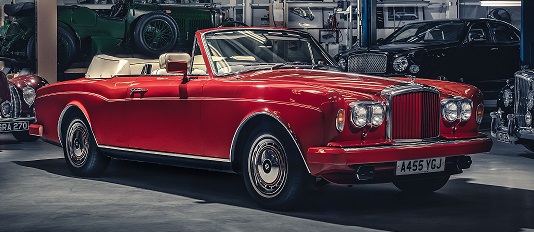

Convertible, 2 Doors, 4 Seats
25.4 l/100 km 9.26 US mpg
15.6 l/100 km 15.08 US mpg
240 Hp @ 4300 rpm.
35.6 Hp/l
205 km/h 127.38 mph
6750 cm3
411.91 cu. in.
8, V-engine
Rear wheel drive,
5196 mm
204.57 in.
1835 mm
72.24 in.
2430 kg
5357.23 lbs.
| Brand | Bentley |
|---|---|
| Model | Continental (Convertible) |
| Version | Continental |
| Engine version | 6.75i (240 Hp) |
| Year production start | 1984 |
| Year production end | 1995 |
| Vehicle type | Convertible |
| Horsepower RPM | 240 Hp @ 4300 rpm. |
| Acceleration 0 - 100 kmh sec | 11.8 sec |
| Curb weight kg -lbs total |
2430 kg5357.23 lbs. |
| Overall length mm - inch |
5196 mm204.57 in. |
| Doors | 2 |
| Top Speed | 205 km/h 127.38 mph |
| Engine position and orientation | Front, Longitudinal |
|---|---|
| Cylinders | 8 |
| Position of cylinders | V-engine |
| Displacement (liters) |
6750 cm3411.91 cu. in. |
| Eng. horsepower RPM | 240 Hp @ 4300 rpm. |
| Horsepower per litre | 35.6 Hp/l |
| Weight / horsepower kg/hp - hp/tons |
10.1 kg/Hp98.8 Hp/tonne |
| Weight / torque kg/Nm - Nm/tons | 5.4 kg/Nm, 185.2 Nm/tonne
5.4 kg/Nm185.2 Nm/tonne |
| Torque Nm RPM lb-ft RPM |
450 Nm @ 1600 rpm.331.9 lb.-ft. @ 1600 rpm. |
| Bore (mm in) |
104.1 mm4.1 in. |
| Stroke (mm in) |
99.1 mm3.9 in. |
| Compression ratio | 9 |
| Fuel delivery system | Multi-point indirect injection |
| Fuel type | Petrol (Gasoline) |
| Valvetrain | 2 |
| Engine aspiration | Naturally aspirated engine |
| Engine oil liters | quarts |
9.4-9.9 l9.93 - 10.46 US qt | 8.27 - 8.71 UK qt |
| Engine coolant |
16.0-18.0 l16.91 - 19.02 US qt | 14.08 - 15.84 UK qt |
| Powertrain architecture | Internal Combustion engine |
| Engine location | Front, Longitudinal |
| Drive configuration | Rear wheel drive |
|---|
| Anti-lock brake system | ABS (Anti-lock braking system) |
|---|
| Turning diameter m - ft |
10.7 m35.1 ft. |
|---|
| Passengers seats | 4 |
|---|---|
| Trunk space max liter | cu. Ft. |
380 l13.42 cu. ft. |
| Overall length mm - inch |
5196 mm204.57 in. |
|---|---|
| Overall width mm -inch |
1835 mm72.24 in. |
| Overall height mm -inch |
1518 mm59.76 in. |
| Wheelbase mm - inch |
3061 mm120.51 in. |
| Curb weight kg -lbs total |
2430 kg5357.23 lbs. |
|---|---|
| Gross weight kg -lbs total |
2760 kg6084.76 lbs. |
| Capacities kg - lbs |
330 kg727.53 lbs. |
| Fuel tank liters | gallons |
108 l28.53 US gal | 23.76 UK gal |
| City l/100km - mpg |
25.4 l/100 km9.26 US mpg |
|---|---|
| Highway l/100 km - mpg |
15.6 l/100 km15.08 US mpg |
8 CYLINDER V-Engine
https://www.thecarspec.net/components/engine/8-cylinders-v